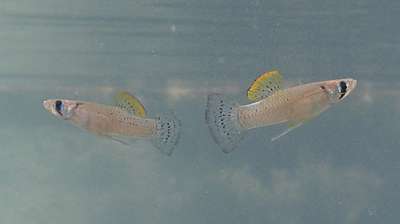Nothing to see here

(Phys.org) —"Blend in" appears to be the mantra for male Bahamas mosquitofish that live near predators. After all, fish with brighter, more colorful fins or patches are more conspicuous – and standing out with predators around could be a death sentence. So these fish evolve duller colors under the threat of predation, to try and hide in the watery background.
Meanwhile, male Bahamas mosquitofish that live in water without predators glam it up to attract females or outcompete other males for access to females. Brighter fins and color patches provide greater contrast with water and cave walls, making these fish really stand out in the water.
Those are the results of a paper on the evolution of fish coloration published online in the journal Evolution.
The study examined Gambusia hubbsi fish in so-called "blue holes" in the Bahamas. These "water islands" provide remarkable natural laboratories for comparing fish living under the threat of predation with those living in the absence of any major predators, says study senior author Brian Langerhans, an assistant professor of biological sciences at NC State. The paper's corresponding author is Ryan Martin, a former postdoctoral researcher in the Langerhans lab who is now an assistant professor at Case Western Reserve University.
"Blending in makes sense when you're trying to avoid being eaten," Martin says. "Less is certainly more when predators are around."
The study examined a number of different environmental factors and individual traits to uncover variation in male colors.
"For example, we found that the background water color of individual blue holes mattered greatly – male mosquitofish evolved colors that stood out in the absence of predators, but tended to blend in with the background in the presence of predators," Langerhans said. "We also found that G. hubbsi males with brighter colors had smaller testes. We think this may reflect variation in male mating strategies, where dull-colored males invest heavily in fertilization success and spend much of their time attempting to copulate with unreceptive females, while colorful males invest instead in mating success and spend more time 'courting' females to gain cooperative copulations."
Langerhans and Ph.D. student Justa Heinen-Kay recently published other findings that showed differences correlated with predation that have evolved in the size and shape of the mosquitofish's penis, or gonopodium.
More information: onlinelibrary.wiley.com/doi/10 … 1/evo.12277/abstract
Journal information: Evolution
Provided by North Carolina State University





















